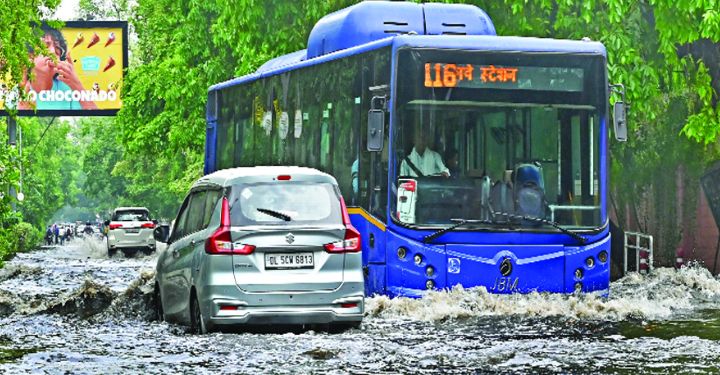As thunder roared across Delhi late Friday night, a furious storm descended on the capital, flooding roads, crippling air traffic, and claiming four lives. While the intensity of the storm shocked many, what followed was even more familiar—waterlogged streets, power outages, diverted flights, and a slow, overwhelmed civic response.
The India Meteorological Department (IMD) had issued a red alert hours before the storm hit. But despite warnings, the city’s infrastructure seemed unprepared, and once again, Delhiites bore the brunt of urban neglect during extreme weather.
Sky Chaos: Flights Rerouted Amid Weather Turmoil
The most immediate fallout was seen at Indira Gandhi International Airport, where at least 49 flights were diverted due to unsafe landing conditions caused by heavy rain and winds touching speeds of 60–70 kmph. Flights en route to Delhi were redirected to nearby cities like Jaipur, Lucknow, and Ahmedabad, leaving passengers stranded for hours.
Scenes of confusion unfolded in terminals, with flight information delayed and many travelers complaining of little communication. “We sat on the tarmac in Jaipur for two hours without food or water. No one told us what was happening,” said Neeraj Malhotra, a traveler from Pune.
The disruption extended into Saturday morning, as delays from diverted aircraft affected the airport’s schedule. In a separate incident, part of the canopy at Terminal 3 was dislodged by strong winds, raising safety concerns about even recently built infrastructure.
Flooded Roads, Stranded Citizens
Delhi’s streets turned into lakes overnight. Areas like Minto Road, Lajpat Nagar, and parts of Dwarka saw water levels rise alarmingly. Underpasses became ponds, and key roadways were choked with stalled vehicles.
Traffic slowed to a crawl by morning, with thousands of office-goers and commuters stuck in the aftermath. Metro services were unaffected, but access to stations was difficult in many flooded areas.
Despite promises of “monsoon readiness” from municipal corporations, the first major storm of the season overwhelmed Delhi’s fragile drainage systems. “How many more years do we have to live like this?” asked Aruna Joshi, a school teacher in Karol Bagh. “This is not nature’s fault—it’s the administration’s.”
Lives Lost in Dwarka: Shelter Turns Deadly
In a heartbreaking incident in Kharkhari village in Dwarka, four laborers died when a tree uprooted by the storm collapsed on the tin-roofed tubewell shed they were sheltering in. A fifth man was injured and rushed to the hospital in critical condition.
The victims were reportedly daily-wage workers seeking cover from the rain. Firefighters and police reached the spot swiftly, but rescue efforts were too late. The incident highlights the vulnerability of Delhi’s poorest residents during such extreme events, who often lack access to safe shelter.
Power Outages, Poor Communication Compound Crisis
Large parts of the city plunged into darkness as winds knocked down electric lines and transformers. In areas like Preet Vihar, Green Park, and parts of North Delhi, power cuts lasted up to 12 hours. Residents faced disrupted water supplies and patchy internet and phone services.
Utility providers deployed emergency teams, but restoration was slow due to the scale of the damage. “The worst part wasn’t the storm—it was not knowing when power would come back,” said Rajat Kapoor, a resident of Laxmi Nagar.
A Pattern Too Familiar: Warnings Ignored
Experts have long warned that Delhi’s urban design is incompatible with its changing climate. The city’s drains are outdated, its trees often uninspected, and power lines remain vulnerable to wind and rain. Despite multiple episodes of similar damage in past years, systemic upgrades have remained piecemeal.
“This isn’t an act of God,” said Dr. Kavita Narayan, an urban policy researcher. “It’s a failure of preparation. The fact that the same roads flood, the same flights are delayed, and the same trees fall shows that nothing has changed.”
IMD and the Climate Context
IMD officials confirmed the storm was part of an ongoing pattern of intensified pre-monsoon activity. “Delhi is now experiencing what we call high-intensity, short-duration storms—difficult to predict precisely but highly destructive,” said a senior IMD meteorologist.
The IMD has urged residents to monitor weather advisories, stay indoors during severe alerts, and avoid parking under trees or electric poles during such events.
Government Promises Action—Again
Delhi’s Lieutenant Governor and Chief Minister both held emergency meetings on Saturday morning. Officials from the Public Works Department, NDMC, and disaster response teams were directed to expedite road clearance and review all flood-prone zones.
Announcements were made for new audits of weak trees and fresh rounds of drain desilting before peak monsoon arrives in late June. But for many Delhi residents, these actions feel too late—and too temporary.
“This is déjà vu,” said civic activist Meena Khurana. “What Delhi needs is a 10-year climate adaptation plan, not post-flood patchwork.”
Conclusion: Another Storm, Same Questions
Friday’s storm was not an anomaly—it was a forecast of Delhi’s future. If the capital continues to respond instead of prepare, each new weather event will bring more damage, more disruptions, and more lives lost.
The question isn’t whether the next storm will come. It’s whether Delhi will be ready when it does.





More Stories
Stranded Before the Festival: Air India Flight Cancellation Leaves Dozens in Milan Without a Way Home for Deepavali
Massive Gujarat Cabinet Overhaul: Harsh Sanghavi Promoted, Rivaba Jadeja Makes Political Debut
India Rejects Trump’s Statement on Russian Oil, Reaffirms Energy Sovereignty